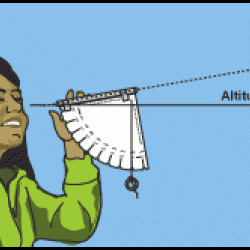Source Institutions
Source Institutions
Add to list Go to activity
Activity link broken? See if it's at the internet archive

In this activity, learners use an astrolabe to measure the altitude of objects. Learners will first practice taking measurements by measuring the altitude of trees and buildings. Then, learners will measure the altitude of the Sun one day a week, at the same time each day, three times. Learners will track the changes in the measurements to better understand why days are longer in the summer and shorter in the winter.
- 5 to 10 minutes
- 1 to 4 weeks
- $1 - $5 per student
- Ages 6 - 14
- Activity
- English
Quick Guide
Materials List (per student)
Subjects
-
Earth and Space Science
- Astronomy
-
Earth, Moon and Sun
- Days
- Seasons
-
Solar System
- The Sun
-
Mathematics
-
Data Analysis and Probability
- Data Analysis
- Data Collection
- Geometry
- Measurement
-
Data Analysis and Probability
-
Engineering and Technology
- Technology
-
The Nature of Science
-
The Scientific Process
- Conducting Investigations
- Gathering Data
- Formulating Explanations
- Communicating Results
-
The Scientific Process
Informal Categories
- Outdoor Activity
Audience
To use this activity, learners need to:
- see
- read
- touch
Learning styles supported:
- Involves hands-on or lab activities
Other
Components that are part of this resource:
- The Astrolabe: An Instrument with a Past and a Future
- Making a Simple Astrolabe (activity)
- "equinoxes, precession of the" From Britannica Online
This resource is part of:
Access Rights:
- Free access
By:
Rights:
- All rights reserved, UC Regents, 2001
